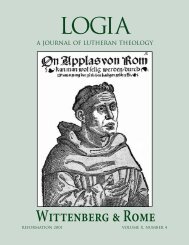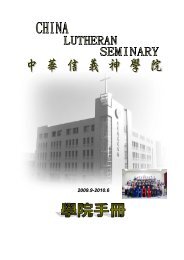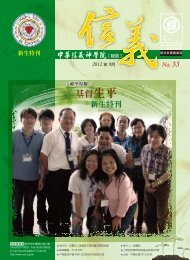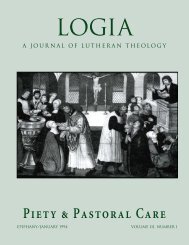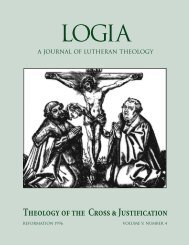04-2 Hermeneutics.pdf
04-2 Hermeneutics.pdf
04-2 Hermeneutics.pdf
- No tags were found...
Create successful ePaper yourself
Turn your PDF publications into a flip-book with our unique Google optimized e-Paper software.
60 LOGIAparticularly disappointing. He is mainly concerned with Cranmer’sPrayer Book of 1549 and 1552, and ignores the creative workin the wider Anglican communion in recent decades. Even moredisappointing is the Lutheran contribution by the NorwegianNorvald Yri. This is mainly concerned to stress principles of worshipagainst the Roman position, and in places sounds moreReformed than Lutheran. He plays down the historic Lutheranliturgical tradition, and an opportunity is lost by not mentioningthe “Thomas Mass” pioneered by the Finnish Lutheran Church,where traditional liturgy is combined tastefully with more colloquialand ad hoc forms.The third section looks at worship in some “Free Church” traditions.The English contribution by Peter Lewis is an uninspiringpiece, and his assertion that Elizabeth I reintroduced the 1549Prayer Book is simply incorrect. This essay, however, contrasts withthe others in this section, particularly those from Latin America.These latter show awareness of the importance of culture and hintat the need to develop sound Latin American worship, reflectingthe culture, and not mere imitations of the worst aspects of NorthAmerican popular revivalist worship. The essay by Sue Brown onstudent worship shows considerable sensitivity.A final essay by Miroslav Volf gives a useful systematic reflection,and suggests that conservative evangelicals have something tolearn from Eastern Orthodox worship.The collection is a sign that worship is being thought about ina more reflective manner in some conservative evangelical circles,and it is hoped it will raise further discussion and work. Thosefrom a more serious liturgical tradition and those who are liturgicallyliterate will find this a frustrating book and at times superficial.For the latter it is a book to borrow rather than to buy.Bryan D. Spinks, Divinity FacultyUniversity of Cambridge, EnglandCounseling at the Cross: Using the Power of the Gospel in ChristianCounseling. By H. Curtis Lyon. Mllwaukee: NorthwesternPublishing House, 1991. 161 pages.■ The title of the book says it all. When dealing with troubledconsciences and unresolved guilt it is time for the Lutheran pastorto take his parishioner on a “quantum leap.” Put the layman in themental time machine. Do meditative gymnastics and take a tripback to the cross.Here is the advice given by the author to one counselee whohad found it difficult to forgive: “I invited her to come on an imaginarytrip through time and space with me. The time was Good Friday,the place Calvary. What did she see? She saw Jesus on thecross” (p. 87). How could this woman continue to keep her forgivingattitude? Answer: “She would keep going back to the cross toremember what Jesus did for her and everyone else” (p. 89). At theend of the book some “techniques” for obtaining resolution aregiven. Again we have the mental gymnastics of a quantum leap.The pastor tells the counselee, “Come with me in your imaginationto where Jesus died. Imagine the cross, the nails, the soldiers andeverything. What is Jesus doing there?” (p. 131). In addition, we aregiven these words: “Because of the personal experiences I have hadseeing gospel resolution at work, I have almost stopped talkingabout forgiveness by itself. I have replaced the simple words ‘Youare forgiven’ with a trip to the cross and a declaration of redemptionthat many of the people in the congregation have experiencedalone in the office in a counseling session” (pp. 155–156).That is the essence of the book. The question remains: Is thismental time travel, as the subtitle of the book suggests, the powerof the gospel? The answer is quite simply “No!” The gospel is notan abstraction. The gospel is not backward time travel done inthe head. The gospel is the actual, located, concrete, delivery ofthe forgiveness of sins in the present. The pastor and the counseleedo not take quantum leaps. We do not go back in time to Calvary.That is impossible both physically and mentally. God doesthe time travel! He enters our time and space through the Spiritedword of the gospel and his holy sacraments. Through the Officeof the Holy Ministry Jesus himself delivers the benefits of Calvaryand the empty tomb into our ears and mouths (AC IV, V, IX, X,XI, XIII XXV, XXVIII).This book demonstrates the confusion that reigns inLutheran parishes (especially in those that consider themselves tobe “conservative”) in America regarding the forgiveness of sinsand how it is bestowed on us. We would do well to hear for thefirst time or to listen again to father Luther. In Against the HeavenlyProphets (1525) he states:We treat of the forgiveness of sins in two ways. First, howit is achieved and won. Second, how it is distributed andgiven to us. Christ has achieved it on the cross, it is true.But he has not distributed or given it on the cross. Hehas not won it in the supper or sacrament. There he hasdistributed and given it through the Word, as also in thegospel, where it is preached. He has won it once for allon the cross. But the distribution takes place continuously,before and after, from the beginning to the end ofthe world. ... If I now seek the forgiveness of sins, I do notrun to the cross, for I will not find it there. Nor must I holdto the suffering of Christ, as Dr. Karlstadt trifles, in knowledgeor remembrance, for I will not find it given thereeither. But I will find in the sacrament or gospel the wordwhich distributes, presents, offers, and gives to me thatforgiveness which was won on the cross (AE 40:213–214,emphasis added).Therefore Luther has rightly taught that whoever has a bad consciencefrom his sins should go to the sacrament and obtain comfort.(See also Confession Concerning Christ’s Supper, 1528, AE37:192–193.)We do not hop into the mental time machine and go back toCalvary. That is the way of Carlstadt. His way is anthropocentric.It runs in the way of the law. There is no certainty there. Were youreally there? Did you really take the ultimate trip to the cross? Theother option is the gospel way. It is christocentric. Christ does theverbs. He gets the job done. He delivers Calvary to us in thepreached gospel, Holy Baptism, Holy Absolution, and Holy Communion.They are holy because they belong to him. They do whatthey say. They give the forgiveness of sins. That is certain and sure.That is the gospel.






